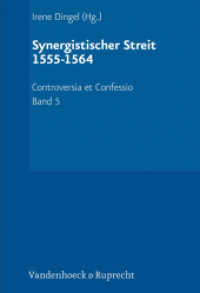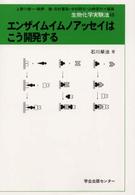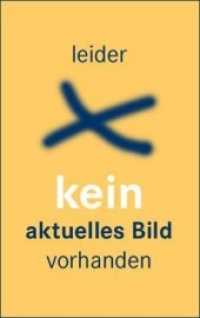- ホーム
- > 洋書
- > ドイツ書
- > Mathematics, Sciences & Technology
- > Mathematics
- > geometry
Full Description
The Curves The Point of View of Max Noether Probably the oldest references to the problem of resolution of singularities are found in Max Noether's works on plane curves [cf. [148], [149]]. And probably the origin of the problem was to have a formula to compute the genus of a plane curve. The genus is the most useful birational invariant of a curve in classical projective geometry. It was long known that, for a plane curve of degree n having l m ordinary singular points with respective multiplicities ri, i E {1, . . . , m}, the genus p of the curve is given by the formula = (n - l)(n - 2) _ ‾ "r. (r. _ 1) P 2 2 L. . ,. •• . Of course, the problem now arises: how to compute the genus of a plane curve having some non-ordinary singularities. This leads to the natural question: can we birationally transform any (singular) plane curve into another one having only ordinary singularities? The answer is positive. Let us give a flavor (without proofs) 2 on how Noether did it • To solve the problem, it is enough to consider a special kind of Cremona trans formations, namely quadratic transformations of the projective plane. Let ‾ be a linear system of conics with three non-collinear base points r = {Ao, AI, A }, 2 and take a projective frame of the type {Ao, AI, A ; U}.
Contents
I Valuation Theory.- 1 Marot Rings.- 2 Manis Valuation Rings.- 3 Valuation Rings and Valuations.- 4 The Approximation Theorem For Independent Valuations.- 5 Extensions of Valuations.- 6 Extending Valuations to Algebraic Overfields.- 7 Extensions of Discrete Valuations.- 8 Ramification Theory of Valuations.- 9 Extending Valuations to Non-Algebraic Overfields.- 10 Valuations of Algebraic Function Fields.- 11 Valuations Dominating a Local Domain.- II One-Dimensional Semilocal Cohen-Macaulay Rings.- 1 Transversal Elements.- 2 Integral Closure of One-Dimensional Semilocal Cohen-Macaulay Rings.- 3 One-Dimensional Analytically Unramified and Analytically Irreducible CM-Rings.- 4 Blowing up Ideals.- 5 Infinitely Near Rings.- III Differential Modules and Ramification.- 1 Introduction.- 2 Norms and Traces.- 3 Formally Unramified and Unramified Extensions.- 4 Unramified Extensions and Discriminants.- 5 Ramification For Quasilocal Rings.- 6 Integral Closure and Completion.- IV Formal and Convergent Power Series Rings.- 1 Formal Power Series Rings.- 2 Convergent Power Series Rings.- 3 Weierstraß Preparation Theorem.- 4 The Category of Formal and Analytic Algebras.- 5 Extensions of Formal and Analytic Algebras.- V Quasiordinary Singularities.- 1 Fractionary Power Series.- 2 The Jung-Abhyankar Theorem: Formal Case.- 3 The Jung-Abhyankar Theorem: Analytic Case.- 4 Quasiordinary Power Series.- 5 A Generalized Newton Algorithm.- 6 Strictly Generated Semigroups.- VI The Singularity Zq = XYp.- 1 Hirzebruch-Jung Singularities.- 2 Semigroups and Semigroup Rings.- 3 Continued Fractions.- 4 Two-Dimensional Cones.- 5 Resolution of Singularities.- VII Two-Dimensional Regular Local Rings.- 1 Ideal Transform.- 2 Quadratic Transforms and Ideal Transforms.- 3 Complete Ideals.- 4 Factorization ofComplete Ideals.- 5 The Predecessors of a Simple Ideal.- 6 The Quadratic Sequence.- 7 Proximity.- 8 Resolution of Embedded Curves.- VIII Resolution of Singularities.- 1 Blowing up Curve Singularities.- 2 Resolution of Surface Singularities I: Jung's Method.- 3 Quadratic Dilatations.- 4 Quadratic Dilatations of Two-Dimensional Regular Local Rings.- 5 Valuations of Algebraic Function Fields in Two Variables.- 6 Uniformization.- 7 Resolution of Surface Singularities II: Blowing up and Normalizing.- Appendices.- A Results from Classical Algebraic Geometry.- 1 Generalities.- 1.1 Ideals and Varieties.- 1.2 Rational Functions and Maps.- 1.3 Coordinate Ring and Local Rings.- 1.4 Dominant Morphisms and Closed Embeddings.- 1.5 Elementary Open Sets.- 1.6 Varieties as Topological Spaces.- 1.7 Local Ring on a Subvariety.- 2 Affine and Finite Morphisms.- 3 Products.- 4 Proper Morphisms.- 4.1 Space of Irreducible Closed Subsets.- 4.3 Proper Morphisms.- 5 Algebraic Cones and Projective Varieties.- 6 Regular and Singular Points.- 7 Normalization of a Variety.- 8 Desingularization of a Variety.- 9 Dimension of Fibres.- 10 Quasifinite Morphisms and Ramification.- 10.1 Quasifinite Morphisms.- 10.2 Ramification.- 11 Divisors.- 12 Some Results on Projections.- 13 Blowing up.- 14 Blowing up: The Local Rings.- B Miscellaneous Results.- 1 Ordered Abelian Groups.- 1.1 Isolated Subgroups.- 1.2 Initial Index.- 1.3 Archimedean Ordered Groups.- 1.4 The Rational Rank of an Abelian Group.- 2 Localization.- 3 Integral Extensions.- 4 Some Results on Graded Rings and Modules.- 4.1 Generalities.- 4.3 Homogeneous Localization.- 4.4 Integral Closure of Graded Rings.- 5 Properties of the Rees Ring.- 6 Integral Closure of Ideals.- 6.1 Generalities.- 6.2 Integral Closure of Ideals.- 6.3 Integral Closure ofIdeals and Valuation Theory.- 7 Decomposition Group and Inertia Group.- 8 Decomposable Rings.- 9 The Dimension Formula.- 10 Miscellaneous Results.- 10.1 The Chinese Remainder Theorem.- 10.2 Separable Noether Normalization.- 10.3 The Segre Ideal.- 10.4 Adjoining an Indeterminate.- 10.5 Divisor Group and Class Group.- 10.6 Calculating a Multiplicity.- 10.7 A Length Formula.- 10.8 Quasifinite Modules.- 10.9 Maximal Primary Ideals.- 10.10 Primary Decomposition in Non-Noetherian Rings.- 10.11 Discriminant of a Polynomial.- Index of Symbols.








